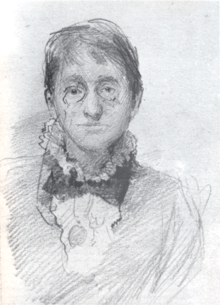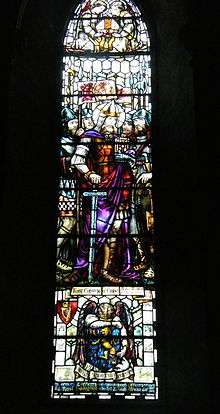Sarah Purser
Sarah Henrietta Purser (22 March 1848 – 7 August 1943) was an Irish artist mainly noted for her work with stained glass.[1]
Sarah Purser | |
|---|---|
 Portrait by John Butler Yeats, c. 1880–1885 | |
| Born | 22 March 1848 Kingstown (now Dún Laoghaire), County Dublin, Ireland |
| Died | 7 August 1943 Dublin, Ireland |
| Resting place | Mount Jerome Cemetery, Dublin, Ireland |
| Nationality | Irish |
| Alma mater | Metropolitan School of Art, Académie Julian |
| Known for | First female member of the Royal Hibernian Academy |
| Movement | stained glass movement |

Personal
She was born in Kingstown (now Dún Laoghaire) in County Dublin, and raised in Dungarvan, County Waterford. She was one of the numerous children of Benjamin Purser, a prosperous flour miller and brewer, and his wife Anne Mallet. She was related to Sir Frederic W. Burton, RHA (1816-1900),[2] who was a son of Hannah Mallet. The Purser family had come to Ireland from Gloucestershire in the eighteenth century. Two of her brothers, John and Louis, became professors at Trinity College Dublin. Her niece Olive Purser, daughter of her brother Alfred, was the first woman scholar in TCD.[3]
Until her death she lived for many years in Mespil House, a Georgian mansion with beautiful plaster ceilings on Mespil Road, on the banks of the Grand Canal. Here she was "at home" every Tuesday afternoon to Dublin's writers and artists; her afternoon parties were a fixture of Dublin literary life.[4] Mespil House was demolished after she died and developed into apartments. She was buried in Mount Jerome Cemetery beside her brothers John and Louis.
Education
At thirteen she attended the Moravian school, Institution Evangélique de Montmirail, Switzerland where she learnt to speak fluent French and began painting. In 1873 her father's business failed and she decided to become a full-time painter. She attended classes at the Dublin Metropolitan School of Art. She joined the Dublin Sketching Club, where she was later appointed an honorary member. In 1874 she distinguished herself in the National Competition. In 1878 she again contributed to the RHA, and for the next fifty years became a regular exhibitor, mainly portraits, and showed an average of three works per show.[5]
In 1878-79, she studied at the Académie Julian in Paris where she met the german painter Louise Catherine Breslau[6] with whom she became a lifelong friend.[7]
Career
Sarah Purser became wealthy through astute investments, particularly in Guinness, for which several of her male relatives had worked over the years. She was very active in the art world in Dublin and was involved in the setting up of the Hugh Lane Municipal Gallery, persuading the Irish government to provide Charlemont House in Parnell Square to house the gallery.[8]
She was the second woman to sit on the Board of Governors and Guardians, National Gallery of Ireland, 1914-1943.
She was made an Honorary Member of the Royal Hibernian Academy in 1890; first female Associate Member in 1923 and the first female Member in 1924.
In 1924 she initiated the movement for the launching of the Friends of the National Collection of Ireland.
Archives relating to Sarah Purser are housed in the Centre for the Study of Irish Art, National Gallery of Ireland.
Portraiture
She worked mostly as a portraitist. Through her talent and energy, and owing to her friendship with the Gore-Booths, she was very successful in obtaining commissions, famously commenting
- "I went through the British aristocracy like the measles."
When the Viceroy of Ireland commissioned her to portray his children in 1888 his choice reflected her position as the country's foremost portraitist.
In 1977 Bruce Arnold noted
- "some of her finest and most sensitive work was not strictly portraiture, for example, An Irish Idyll in the Ulster Museum, and Le Petit Déjeuner (in the National Gallery of Ireland)."
Various portraits painted by Purser are held in the National Gallery of Ireland.
Glass (An Túr Gloine)
Sarah Purser financed An Túr Gloine (The Tower of Glass), a stained glass cooperative, at 24 Upper Pembroke and ran it from its inauguration in 1903 until her retirement in 1940. Michael Healy (1873-1941) was the first of a number of distinguished recruit, such as Catherine O'Brien (1882-1963), Evie Hone (1894-1955), Wilhelmina Geddes (1887-1955), Beatrice Elvery (1881-1970) and Ethel Rhind (c.1879 -1952). Purser was determined the stained glass workshop should adhere to true Arts and Crafts philosophy: 'Each window is the work of one artist who makes the sketch and cartoon and selects and paints every morsel of glass him or herself'.[9]
Purser did not produce many items of stained glass herself. Most of the stained glass works were painted by other members of the co-operative, presumably under her direction. Two early works, 1904, were St. Ita for St. Brendan's Cathedral, Loughrea and The Good Shepard for St. Columba's College, Dublin. Her last stained glass work is thought to be The Good Shepard and the Good Samaritan, 1926, for the Church of Ireland at Killucan, Co. Westmeath.
An Túr Gloine archive is held in the Centre for the Study of Irish Art, National Gallery of Ireland.
See also
References
- National Gallery of Ireland (1987). Irish Women Artists: From the Eighteenth Century to the Present Day. National Gallery of Ireland. ISBN 978-0-903162-40-1.
- "Sir Frederick William Burton, Water-colour Painter - Irish Artists". www.libraryireland.com. Retrieved 2019-08-24.
- "Welcome, Welcome Little Women: TCD's First Female Graduates". News & Alerts: The Library of Trinity College Dublin. 2015-03-09. Retrieved 2019-12-01.
- Terence de Vere White A Fretful Midge Routledge and Kegan Paul London 1957 p.129
- Snoddy, Theo (2002). Dictionary of Irish Artists, 20th Century, second edition. Dublin: Merlin Publishing. p. 540.
- "Objects – Louise Catherine Breslau – Artists – National Gallery of Ireland". onlinecollection.nationalgallery.ie. Retrieved 2018-12-12.
- Breslau, Louise. "Letters to Sarah Purser from Louise Catherine Breslau,". catalogue.nli.ie. Retrieved 2018-12-12.
- Christopher Lloyd (2011). In Search of a Masterpiece. An Art Lover's Guide to Great Britiain & Ireland. Themes & Hudson. ISBN 9780500238844.
- Gordon Bowe, N.; et al. (1988). Gazetteer of Irish Stained Glass. Dublin: Irish Academic Press. p. 19.
Notes
- Sarah Purser at the Princess Grace Irish Library
- Bruce Arnold (1977). Irish art: a concise history (2 ed.) London: Thames and Hudson. ISBN 0-500-20148-X.
- John O'Grady (1996). The Life and Work of Sarah Purser Four Courts Press. ISBN 1-85182-241-0.
External links
4 paintings by or after Sarah Purser at the Art UK site